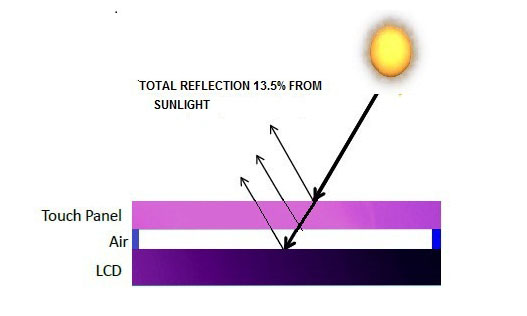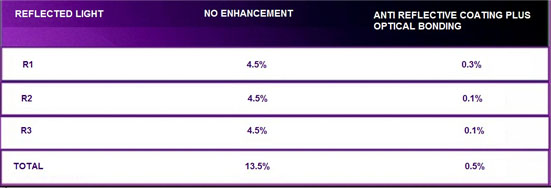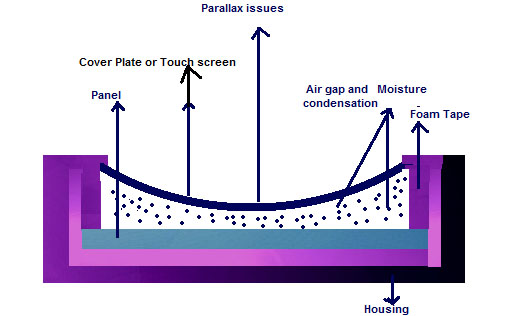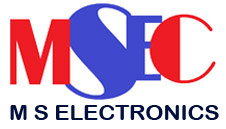
M S Electronics’s optical bonding service is tailored between any specific display and cover lens or touch panels or a combination of both. Our technical team maintains predominant quality control in process. . We use nothing less than the industry-standards in bonding material and in-house processes.
LCD DISPLAYS NATIVE PROBLEM
At outdoors LCDs display one of the fundamental problems and inherent limitations which is their fragile nature. LCDs display front polarizer easily scratched and physically damaged which permanently destroy the quality of the display image due to delicate nature of the polarizer material.. LCD’s polarizer material is very hydrophilic (absorbs water) and can be damaged with prolonged exposure to moisture,rain dew etc.At outdoors and extreme temperatures liquid crystal layer becomes unstable and Mura effects can be viewed.. Due to these fragile characteristics, the image quality of LCD is permanently destroyed.
To protect LCDs additional surfaces, like touch screen ,glass or plastic comes into play .Then.the ability to see a display in sunlight becomes increasingly difficult, due to the additional reflections. Reflection is caused by an impedance mismatch between air and glass or Plastic. This vastly decreases the contrast of the display.
The real problem with LCD outdoor viewability is contrast, not brightness. A display’s contrast ratio is the difference in light intensity between the brightest white pixel and the darkest black pixel. As the ambient light increases, the contrast ratio decreases as more light is reflected by the display. When the ambient light gets bright enough, the contrast ratio is reduced and makes the LCD unreadable.
TRADITIONAL METHODS TO INCREASE SUNLIGHT VIEW ABILITY
The traditional method of making an LCD viewable outdoors is to increase the intensity of the backlight. This attempts to make the viewable light greater than the reflected ambient light or by shifting the display viewing to a higher luminance level and increasing the backlight intensity.This method is impractical because of power-consumption ,heat,and thickness . By adding brightness-enhancement films to the liquid-crystal display (LCD), it avoids all of the inherent issues of the active approach and the achievable brightness increase is limited, which is insufficient for solving the sunlight-readability problem.
M S ELECTRONICS OPTICAL BONDING SOLUTIONS
An efficient technology to reduce reflection is called optical bonding. . Optical bonding means joining two optical elements, such as the display screen and a protective overlay glass or a touch screen. These layers are joined together using a transparent adhesive. Optical bonding eliminates the air gap between the two reflective surfaces of the cover glass or touch screen and the LCD allowing great reductions in reflectance. In optical bonding , an anti-reflective coating is usually applied to the top surface of the cover glass, along with possibly an anti-smudge (AS, hydrophobic) coating and often an anti-glare (AG) treatment.
The goal of optical bonding is to increase the LCD’s contrast ratio by reducing the amount of reflected ambient light. The light reflected from each surface in the optical path of air and glass have different indices of refraction. The greater the difference, the more light is reflected from the interface. Air has an index of refraction of 1.0, while glass has an index of 1.5. This difference results in an average of 4.5% reflected light per surface. M S Electronics uses advanced adhesive material and utilizes a unique bond design to join the cover glass or touch panel with LCD surfaces, which results in an elimination of the ‘air gap’. The end result is an optical Refractive Index match of materials which allows for uniform light transmission and very low reflection. . This is done by utilizing display cover glass with a front surface anti-reflective coating treatment,
Below diagrams shows the reflected light from an LCD with a cover glass or touch panel without and with optical bonding.
Without Optical Bonding

With Optical Bonding

PERCENTAGE OF LIGHT REFLECTION PER ENHANCEMENT LAYOUT

BENEFITS OF OPTICAL BONDED LCD
Optical bonding effectively eliminates the air gap between the cover glass and display. This process increases optical clarity, protects the display from dust and moisture, reduces parallax issues, improves scratch and damage resistance, and is thin and lightweight.
LCD Optical Bonding

Traditional Way

IMPACT RESISTANCE AND RUGDNESS
Bonding over lay glass or touch screen on top of an LCD increases the ruggedness of the LCD. Optical bonding technology with AR-treated cover-glass dramatically improves impact resistance over non-bonded displays in steel ball drop tests performed on LCDs. In fact, the bonding provided is upto to a 300% increase in impact resistance.A bonded display has a better ability to resist scratches, fluids, stains and dirt. This can be considered vandal-proofing to some extent.
SCRATCH RESISTANCE
LCD bonding process increases scratch resistance by 300% over non-bonded display surfaces in scratch tests.
Pencil grades from 2H to 9H were selected and applied to bonded and non-bonded LCD surfaces using sufficient pressure to allow the pencil lead to just crush.
Non-bonded LCD surfaces experienced scratches at 3H while the bonded surface showed no marring or scratches up to 9H.
CONDESATION OR FOGGING
PARALLAX ERROR AND ACCURATE TOUCH
The elimination of the air gap between the cover glass and the LCD, reduces parallax error.Touch monitor with optical bonding maintains consistently accurate touch response making it easy to use and reliable.
SUNLIGHT READABILITY
The increased light transmission of a screen with optical bonding significantly reduces glare from external light sources..Since traditional coverplates often are not treated with anti-reflective (AR) coatings their multiple surfaces result in high reflectivity. By bonding the front AR-coated substrate directly to the display bonding technology creates a single surface with low reflectivity and increases display contrast ratio by as much as 400% for optimum outdoor viewing without increasing power consumption.
HIGH VIBRATION AND SHOCK RESISTANCE
Large displacements of the display glass can occur when LCD monitors are subjected to vibrations. Maximum displacements – where the rear of the LCD glass comes in contact with the backlight unit – can result in film damage and unwanted mura defects. LCD optical bonding process improved an LCD module’ resistance to mechanical shock and vibration over non-bonded LCD modules by 300% in testing.
Improves heat Dissipation
By eliminating the isolating air gap between the panel of glass, heat can dissipate through the front glass.
No contamination
Optical bonding avoids the air gap between the Cover glass or Touchscreen and LCD surfaces and also does not allow dust and dirt to penetrate. The danger of splintering glass is considerably reduced with full-surface bonding with adhesive.
